BY MIKE PIPER
Two firefighters suffered serious burns while conducting a primary search at a dwelling fire in suburban Arvada, Colorado, in the early morning hours of April 3, 2011. Tempting as it may be, dismissing their injuries as the simultaneous convergence of many improbable factors would be a disservice to the burned firefighters and their loved ones, the Arvada Fire Protection District (AFPD), and ultimately to the fire service. The reality is that if firefighters get seriously burned, something went drastically wrong. The members of any such organization have a responsibility to identify what went wrong and to make the changes necessary to prevent it from occurring again. Finger pointing and an impulsive rush to judgment are inappropriate under such circumstances. Organizations must have the courage to be honest and transparent when their firefighters are seriously injured or killed, as did the Phoenix (AZ) Fire Department following the death of Firefighter Bret Tarver in 2001.
Through the years, many fire departments have swallowed their pride for the sake of the greater good, and I am humbled to admit that this time it’s our turn. Although I always realized something like this could happen, I never really thought that it would. I was wrong. It happened to us, and now I believe more than ever it might happen to your department, too. Below is the story of what happened at a suburban single-family-dwelling fire, what should have happened, and what we learned when we got burned.
SITUATIONAL AWARENESS
Wind-driven fires have been a recent subject in fire service studies and publications. Suburban fire departments like the AFPD may not see the relevance of wind-driven high-rise fire studies done in big cities like Chicago and New York City. But wind is wind and fire is fire, and wind-driven fires in Arvada, Colorado, are no different from those in Chicago or New York City. When the wind blows, it makes fires bigger and hotter. Conditions at wind-driven fires can change very quickly, and that is precisely what happened at the Union Street Fire on April 3, 2011.
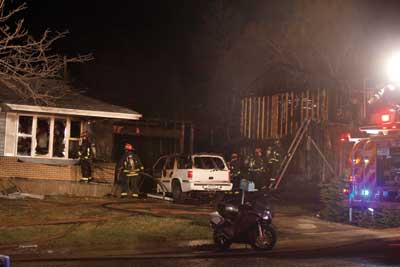 |
| (1) The fire began in a grill at the rear exterior of the dwelling on the left behind the garage. Winds of 35 mph spread the fire to the exterior of the dwelling on the right before the arrival of the first-responding truck company. (Photos by Derek Broussard unless otherwise noted.) |
The burned firefighters were searching a bi-level single-family dwelling exposed by the original fire, which involved a single-story, single-family dwelling. The exposed dwelling’s exterior rear deck and attached wood-frame canopy were burning as firefighters searched the interior, which they thought was “routine” until conditions rapidly changed. The deck and canopy were well involved, whereas conditions inside the dwelling were tenable. But because of heat from the exterior fire, a sliding patio door failed, and 35-mile-per-hour (mph) winds blew the exterior fire directly on the two searching firefighters. The strong influx of oxygen and fire also provided ideal conditions for the ignition of the combustion products, which were already accumulating at the ceiling level inside the exposed dwelling. In an instant, the tenable interior conditions were transformed into an inferno that caused the two firefighters to be separated and seriously burned while conducting a “routine” primary search.
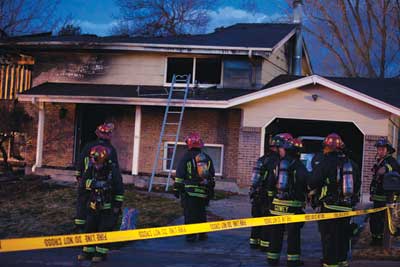 |
| (2) The injured firefighters were conducting a primary search on the second floor of this dwelling when they sustained serious burn injuries. |
The physical evidence indicates that the products of combustion entered the exposed home through a gable end vent, thus spreading fire into the attic of the exposed dwelling. The burned firefighters noted that the environment in the home was tenable on entry but they did report some smoke in the home when they began their search. Most likely, the smoke came from the attic and entered the living area through an opening in the ceiling for a whole-house attic fan. Physical evidence did not indicate a flashover occurred, but the combustion products accumulated at the ceiling and likely were also a factor when the patio door failed and the wind-driven fire on the exterior entered the exposed home.
 |
| (3) At center, the grill behind the garage where the fire originated. The propane tank involved is to the right under a second grill. Behind is the exposure’s rear deck. (Photo by Randall Weigum.) |
Personally, I believe that the firefighters were unaware that they had fire above them in the attic during their search. Also, I believe they did not know the extent of fire on the exterior, since they did not conduct a 360° size-up prior to entry.
Firefighters and incident commanders must seriously consider modifying “typical” dwelling fire strategies and tactics when there are high winds. Recent research indicates that wind speeds as low as 10 mph can significantly affect the fire behavior inside structures. The critical fireground factor of high-wind conditions must be considered when determining the incident strategy and tactics. Firefighters must be aware that, when there are high winds, interior conditions in structural firefighting can rapidly change.
Since hindsight is 20/20, controlling the fire on the exterior before entering the exposed dwelling to conduct a search might very well have prevented the serious burns that the two firefighters sustained. In this instance, the first-arriving truck company did what it always does on arrival. Since the dispatch center reported “parties trapped,” and there were no occupants seen outside of either involved dwelling on arrival, the company proceeded to conduct a search in both dwellings. The four-member truck company split into two groups of two: The captain and a firefighter proceeded to conduct a search in the more involved dwelling while the engineer (a senior firefighter) and the remaining firefighter searched the exposed dwelling. The truck company initiated primary searches even though the nearest engine company was still minutes away. It’s how we’ve always operated, and it always worked out fine. Aggressive? Yes. Dangerous? Yes. Did the search fall into the “risk a lot to save a lot” category based on the information firefighters knew at the time? Yes.
What we knew before but know really well now is that high winds drastically increase the probability that a hostile event will occur inside a structure. Despite reports of “parties trapped,” firefighters and incident commanders should seriously consider getting the fire under control from the exterior before undertaking search operations at dwelling fires during high-wind conditions. This is not to say that truck companies should initiate the fire attack but rather to emphasize that the fire attack may be a higher priority than search operations during wind-driven dwelling fires. The only thing separating the firefighters on the interior from the wind-driven inferno on the exterior may be just a pane or two of glass. When that glass fails, as it will when exposed to enough radiant heat, a venturi effect may result, trapping firefighters in a constricted section of the building.
IMPROVE INTERAGENCY COMMUNICATIONS
Although some may hate to admit it, police officers are much like firefighters and follow the usual procedure for a situation. Arvada police officers normally arrive first and verify the presence of occupants at dwelling fires—and did so at the Union Street Fire. The police officers arrived first and confirmed that the fire structure and an adjacent involved exposure were evacuated. Police officers also directed the evacuated occupants to relocate at a nearby elementary school. The officers escorted the occupants to the evacuation site, but the fact that the involved dwellings were unoccupied was never conveyed to fire department responders on arrival. The burned firefighters and the incident commander might have terminated the search if they had known that the dwelling they were searching was unoccupied.
| Figure 1. Progress of the Fire |
 |
|
1. Smoldering briquettes from a charcoal barbecue lit in a propane grill the evening before were not extinguished. The following morning, 20-35 mph wind gusts blew the embers onto the combustibles on the patio, igniting them. 2. The fire melted a full five-gallon plastic gasoline container. It also burned through a hose connecting a 20-pound propane cylinder (with an open valve) to a second grill, igniting the gas. High winds spread the fire to the garage through a missing window and to the dwelling’s attic, living area, and kitchen. 3. Embers and radiant heat spread the fire to the exposed dwelling’s rear deck and wood-frame canopy. 4. Fire entered the exposure’s attic through the gable end. 5. The exposure’s sliding glass door on the deck failed, spreading the fire into the dwelling’s interior, engulfing the two firefighters as they conducted a primary search. 6. Winds of 35 mph fueled the fire, now burning in the exposed dwelling. |
Once again, “inadequate communication” is a significant contributing factor to fireground injuries. All emergency responders must be adequately trained and encouraged to convey known information relevant to occupancy status to the first-arriving unit from the fire department. You must conduct interagency training to help police officers understand how occupancy status drives the incident strategy and impacts firefighter safety.
COMMAND AND CONTROL
The bottom line is that at dwelling fires where there are high winds, company officers and incident commanders must seriously consider modifying the strategy from offensive to defensive. Since conditions can change so quickly, even in tenable environments, the value of a primary search for anything other than known trapped victims can be negligible. What presents itself as a “bread-and-butter” fire may be anything but that during high-wind conditions. You must consider high-wind conditions when developing the strategy and the incident action plan (IAP).
SUPPORT OPERATIONS
Perhaps the value of placing engine companies next to truck companies is well-known in Chicago and New York City, but we in suburban Arvada, Colorado, certainly appreciate it more now. Had an engine company arrived first or even simultaneously with the truck company, the fire may have been controlled before the search of the exposed dwelling ensued. Conducting search operations without engine company support is very dangerous. As a result of the Union Street Fire, the AFPD developed a plan to place an engine company adjacent to each truck company.
PERSONAL PROTECTIVE EQUIPMENT
When it comes to firefighting gloves and hoods, thicker might be better. Both of the burned firefighters wore full structural firefighting protective ensembles. Although they both likely endured very similar heat exposure, the firefighter wearing a thin carbon hood sustained serious burns to his ears, while the firefighter wearing a thicker hood did not. Moreover, the firefighter wearing gloves that were thin but still complied with National Fire Protection Association 1851, Standard on Selection, Care, and Maintenance of Protective Ensembles for Structural Fire Fighting and Proximity Fire Fighting, sustained much more serious burns to his hands than did the firefighter wearing thicker gloves. Although it is likely we will never know the exact temperatures to which the burned firefighters were exposed, the thickness their ensemble components appeared to have provided cannot be dismissed.
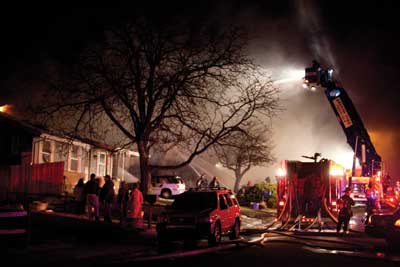 |
| (4) Command declared a defensive strategy after the injured firefighters escaped. |
Consider the terms “comfortable,” “lightweight,” and “meets NFPA requirements” as they pertain to protective ensembles for structural firefighting as nothing more than a marketing strategy. Nothing about conducting a primary search requires comfort or dexterity, so why compromise anyone’s health and safety? Of course, any product purchased should meet NFPA requirements, but there can be significant differences in the level of protection provided, even among products that “meet all NFPA requirements.”
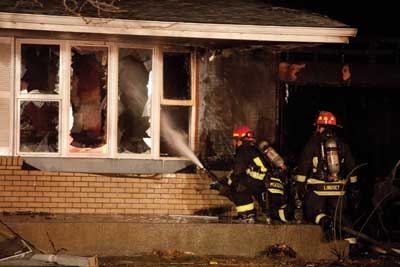 |
| (5) Once a defensive strategy was declared, firefighters brought the fire under control quickly using large-diameter handlines and master streams. |
Note that neither injured firefighter donned the earflaps provided with the helmet, which likely contributed to serious burn injuries to the ears of the firefighter wearing the carbon hood. In addition, the firefighter who sustained a deep burn on the back of his neck did not have a properly secured collar at the time of his injury. A properly secured collar likely would have prevented the deep burn he sustained on the back of his neck.
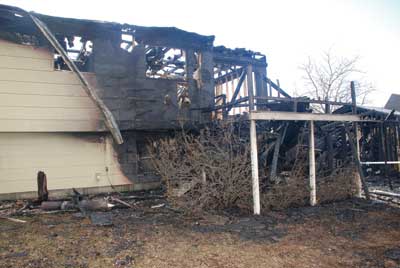 |
| (6) The sliding patio door on the exposure’s deck failed, and fire engulfed the searching firefighters. (Photo by Randall Weigum.) |
In the end, every firefighter needs to properly don every component of the complete structural firefighting protective ensemble. Fire organizations are also responsible for providing the best performing personal protective equipment (PPE) that money can buy for their firefighting force. The features of “comfort” and “lightweight” should not be taken into consideration when purchasing protective ensembles for structural firefighting.
SUPERVISION AND EXPERIENCE
Many fire departments split single companies into smaller groups or squads when the need arises, as did AFPD at the Union Street Fire. An experienced and senior firefighter should be capable of leading and protecting another firefighter at the scene of an incident, right?
It sounds good, and it sure has been effective for AFPD and many other fire departments to operate in this manner. The Union Street Fire, however, changed everything. That two firefighters sustained serious burn injuries begs the question, “Where was their supervisor?” Their captain was at another dwelling at the time of their injuries. Another dwelling? Yes. As previously mentioned, we operated like that all the time, and it always worked out fine.
A fair question, however, is whether firefighters should be operating in immediately dangerous to life and health (IDLH) environments without the supervision of a company officer. After all, AFPD holds mandatory officer development training courses every month, none of which had ever been attended by either of the burned firefighters. They never attended any of the key training courses designed to give supervisors the necessary knowledge to conduct an accurate and ongoing risk/benefit analysis, select an appropriate strategy, and implement an appropriate IAP based on the critical fireground factors. They’re not to blame, though, because they’re not company officers. Difficult as it may be to admit, any organization that places firefighters in supervisory roles but also fails to require corresponding training is ultimately to blame.
The practice of splitting companies into smaller groups or squads and placing firefighters in IDLH environments without the supervision of a company officer requires serious reconsideration. Experienced as that member may be, not every senior firefighter is trained to accurately conduct a risk/benefit analysis, nor is the importance of conducting a 360° size-up on arrival imbedded in them. The senior firefighter typically drives the rig, hits the hydrant, forces the door, stretches the hoseline, or ventilates at dwelling fires. The training and experience necessary to accurately evaluate the critical fireground factors and determine the corresponding strategy and tactics are likely foreign to many senior firefighters. The paradigm shift from a task-oriented firefighter to a strategic-thinking company officer is vast, as any experienced company officer knows.
The practice of placing inexperienced firefighters on truck companies that routinely conduct search operations without the support of an engine company or a hoseline is also something that requires serious reconsideration. Inexperienced firefighters may slow the progress of the primary search, thus increasing the risk to their partner. The practice of “bidding” for vacancies on companies following the Union Street Fire was replaced with the practice of “placing” firefighters on companies to ensure that truck companies are comprised of more experienced firefighters and company officers.
SEARCH PATTERNS
No one can adequately explain why the lower level of the exposed dwelling was initially searched. Maybe some indication that the area was occupied at the time of the incident existed, but neither of the burned firefighters could recall why they began their search on the lower level of the exposed dwelling.
As fate would have it, the firefighters completed their primary search on the lower level of the bi-level dwelling before proceeding to the upper level. Nearing completion of the primary search on the upper level, the firefighters were positioned at the top of a stairwell, just feet from the descent to the dwelling’s main entrance/exit door. A sliding patio door on the upper level of the dwelling failed because of heat exposure from the exterior, and the firefighters found themselves in a direct path between the failed sliding patio door on the windward side of the dwelling and exhaust openings on the leeward side. Thirty-five mph winds pushed the exterior fire inside the now-open dwelling and also fueled and enabled ignition of the interior gases previously accumulating at the ceiling level. Coupled with this, convective heat instantly engulfed and burned the firefighters. According to AFPD investigators, the Colorado Bureau of Investigation, and the Bureau of Alcohol, Tobacco, Firearms and Explosives as well as a private insurance company investigator, a flashover did not occur in the area the firefighters occupied at the time of their injuries.
Based on the reports of every investigator involved as well as that of the injured firefighters, what occurred was that a wind-driven fire entered the dwelling occupied by the burned firefighters, both of whom were wearing a protective structural firefighting ensemble. The temperature and intensity of the fire completely engulfed the two firefighters, briefly causing them to become separated. Heat conditions were so intense that a portable radio one firefighter wore melted, and an electrical short transmitted a distress signal to the fire department dispatch center. Fortunately, the senior firefighter engaged in a valiant search to locate his partner and then directed him to the nearest exit.
Had the firefighters initiated their search in the most dangerous section of the dwelling (the upper level), they would likely have been in a safer area when the glass patio door failed and the wind-driven event ensued on the upper level. This is not to say that they acted or searched inappropriately, since they likely did have a legitimate reason for searching the lower level of the structure first. It’s just to reinforce that firefighters need to conduct search operations in the highest-risk areas first and then proceed to search the less-hazardous areas. As fire grows and intensifies, the hazard to the firefighters working in that same area also significantly increases.
SEARCH ROPES
Every firefighter thinks he can quickly find his way out of a single-family dwelling if and when it becomes necessary. After all, a window or door exists in most rooms in a dwelling, right? Why deploy a lifeline or search rope in a building with such a simple floor plan? Search ropes get tangled and wrapped around everything in the “real world,” making the search even more difficult and time consuming, right?
As prepared as we may perceive ourselves to be, the reality is that nobody ever really thinks he will be instantly engulfed by fire and require a search rope or lifeline to lead him to safety. It’s like the thin hood or the comfortable structural firefighting gloves that enhance dexterity. It all sounds great among friends in an air-conditioned firehouse with perfect visibility.
Deploying a search rope isn’t for the fire you can easily find your way out of. Of course, you’ll never need it; and, of course, there is normally a quick way out of most rooms in a dwelling fire. Deploying a search rope or lifeline is for the unexpected hostile event, like the very thick hood, the properly donned collar and ear flaps, and the reduced-dexterity gloves that provide that extra layer of protection when what’s burning is your skin. Deploy a search rope or lifeline whenever you conduct a primary search in an IDLH environment, regardless of whether conditions are tenable at the onset of the search.
DISPATCH
Usually, dispatchers are the first emergency service personnel to become aware that a dwelling fire is unfolding. They have access to information that is critically important to emergency responders. Civilians call 911 to report their observations. If dispatchers are fortunate, they can accurately determine whether there are occupants at a reported dwelling fire. In the city of Arvada, the Arvada Police Department receives all 911 calls. Callers reporting fire and medical emergencies are transferred to the fire department dispatch center. During the Union Street Fire, a police department dispatcher’s analysis of a disconnected 911 call was that civilians were likely trapped in a dwelling fire. This information was conveyed to the fire department dispatchers, who then reported it to responding firefighters. Unfortunately, the information was inaccurate and influenced the decision to undertake an offensive strategy. The fire department dispatchers never challenged the information from the police department dispatchers, nor did they attempt to obtain more specific information about who was entrapped or where they were located. Had the fire department dispatchers pursued this information from the police department dispatchers, the reality that both of the involved dwellings were unoccupied may have been available to emergency responders and probably would have influenced the decision to conduct the primary search.
WHAT WENT “RIGHT”
Although I have skeptically read my fair share of postincident reviews generated by the fire service, it must be noted that many aspects of the Union Street Fire did in fact go remarkably well. Initial-arriving engine companies established a redundant water supply, and the fire in both involved dwellings was brought under control very quickly. Firefighters on the exterior of the exposed dwelling were perceptive and disciplined. Despite serious burn injuries, the senior firefighter on the first-arriving truck company conducted a valiant search for his partner, located him, and led him to the nearest exit. One company on the exterior of the exposed dwelling noticed a firefighter in distress near an exit and assisted both injured firefighters to safety. The responding firefighters and company officers followed the standard operating guidelines existing at the time of the incident. The incident commander and all other fire department responders demonstrated strength and courage in the face of adversity and a genuine commitment to the mission of the fire service.
A variety of factors converged that resulted in serious burn injuries to two Arvada firefighters at a single-family dwelling fire on April 3, 2011. Although the firefighters escaped and are expected to make a full recovery and return to duty, the Union Street Fire shed light on the importance of maintaining situational awareness, modifying the incident strategy and IAP during high winds, engine company support, properly donning PPE, firefighter experience levels, and the role that dispatchers and police officers fulfill during structure fires. Most importantly, the Union Street Fire was evidence that “bread-and-butter” dwelling fires can quickly escalate into unthinkable events during high-wind conditions.
MIKE PIPER is the deputy chief of the Arvada (CO) Fire Protection District and a 20-year veteran of the fire service. He has a bachelor’s degree in philosophy from the University of Colorado and an associate degree in fire science technology from Red Rocks Community College. He is a certified fire officer III and is also enrolled in the National Fire Academy’s Executive Fire Officer Program.
More Fire Engineering Issue Articles
Fire Engineering Archives

